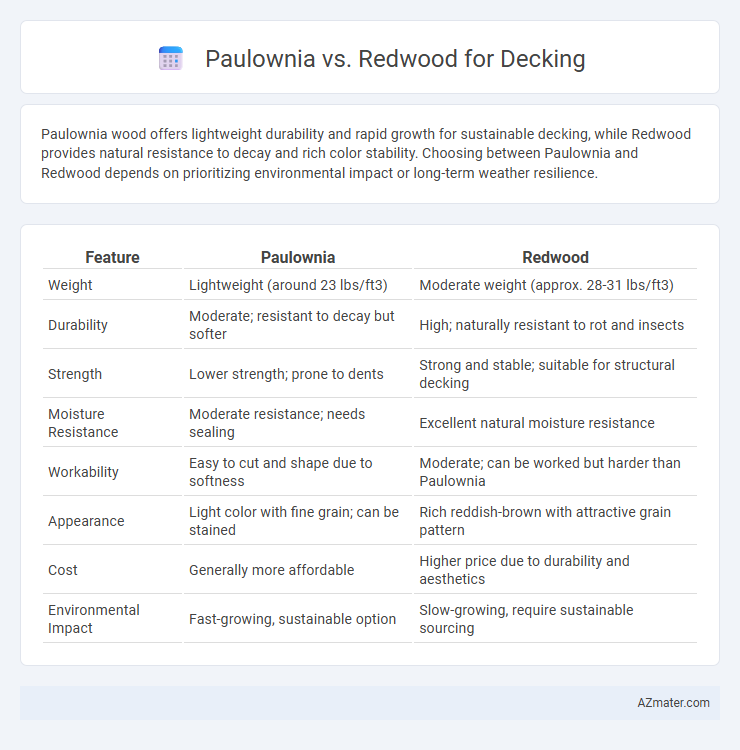Paulownia wood offers lightweight durability and rapid growth for sustainable decking, while Redwood provides natural resistance to decay and rich color stability. Choosing between Paulownia and Redwood depends on prioritizing environmental impact or long-term weather resilience.
Table of Comparison
| Feature | Paulownia | Redwood |
|---|---|---|
| Weight | Lightweight (around 23 lbs/ft3) | Moderate weight (approx. 28-31 lbs/ft3) |
| Durability | Moderate; resistant to decay but softer | High; naturally resistant to rot and insects |
| Strength | Lower strength; prone to dents | Strong and stable; suitable for structural decking |
| Moisture Resistance | Moderate resistance; needs sealing | Excellent natural moisture resistance |
| Workability | Easy to cut and shape due to softness | Moderate; can be worked but harder than Paulownia |
| Appearance | Light color with fine grain; can be stained | Rich reddish-brown with attractive grain pattern |
| Cost | Generally more affordable | Higher price due to durability and aesthetics |
| Environmental Impact | Fast-growing, sustainable option | Slow-growing, require sustainable sourcing |
Introduction to Paulownia and Redwood for Decking
Paulownia offers a lightweight, fast-growing hardwood option with excellent resistance to warping and moisture, making it ideal for decking in various climates. Redwood, known for its natural durability and rich reddish hue, provides strong resistance to decay and insect damage, ensuring long-lasting outdoor performance. Both woods are prized choices for decking, balancing aesthetic appeal with structural integrity.
Wood Properties: Paulownia vs Redwood
Paulownia wood is lightweight, with a density around 260 kg/m3, offering exceptional dimensional stability and rapid growth, making it eco-friendly and resistant to warping. Redwood has a higher density of approximately 450 kg/m3, providing superior natural durability and resistance to decay, insects, and moisture compared to Paulownia. While Paulownia excels in ease of handling and insulation, Redwood's robust hardness and longevity make it ideal for long-lasting, high-traffic decking applications.
Durability and Weather Resistance
Paulownia wood offers lightweight durability but is less dense and more prone to dents and scratches compared to Redwood, which has a naturally high resistance to decay and insect damage due to its tannin content. Redwood excels in weather resistance, maintaining structural integrity and color even under prolonged exposure to moisture and UV rays, whereas Paulownia requires additional sealing and maintenance to withstand harsh outdoor conditions. For long-term decking projects, Redwood's superior durability and weather resistance make it a more reliable choice in varying climates.
Weight and Workability Comparison
Paulownia is significantly lighter than redwood, with a density around 0.28 g/cm3 compared to redwood's 0.45 g/cm3, making it easier to handle and transport for decking projects. Its softness and low density allow for effortless cutting, sanding, and fastening, reducing labor time and tool wear compared to the denser, moderately soft redwood. While redwood offers more natural resistance to decay and insects, paulownia's superior workability and lightweight properties make it a preferred choice for DIY decking installations requiring easier manipulation.
Sustainability and Environmental Impact
Paulownia wood is celebrated for its rapid growth and carbon sequestration capabilities, making it a highly sustainable choice for decking with minimal environmental impact. Redwood, while naturally resistant to decay and pests, grows much slower and is often sourced from old-growth forests, raising concerns about habitat disruption and deforestation. Choosing Paulownia decking supports eco-friendly forestry practices due to its fast renewability and lower ecological footprint compared to Redwood.
Cost and Availability
Paulownia decking offers a more affordable option with lower material costs compared to Redwood, making it attractive for budget-conscious projects. Redwood, renowned for its durability and natural resistance to decay, commands higher prices and is less readily available due to limited regional supply. Availability of Paulownia is increasing with expanded cultivation, while Redwood remains predominantly sourced from specific West Coast forests, impacting overall cost and accessibility.
Aesthetic Differences: Color and Grain
Paulownia decking features a light, pale beige color with subtle grain patterns, offering a modern and minimalist aesthetic ideal for contemporary outdoor spaces. Redwood showcases rich, deep reddish hues with pronounced, swirling grain, providing a warm and classic appearance that enhances traditional and rustic deck designs. Both woods develop unique character over time, but Paulownia tends to maintain a lighter, cooler tone, whereas Redwood deepens in color, emphasizing its natural beauty.
Maintenance Requirements
Paulownia decking requires minimal maintenance due to its natural resistance to decay and insect damage, often needing only occasional cleaning and resealing to maintain its appearance. Redwood, while durable and naturally resistant to rot and insects, demands more frequent maintenance such as annual cleaning, staining, or sealing to prevent weathering and preserve its rich color. Both woods benefit from proper sealing, but Paulownia's lightweight and fast-growing nature make it a lower-maintenance and eco-friendly alternative for decking projects.
Lifespan and Long-Term Performance
Paulownia wood offers moderate lifespan and durability, typically lasting 10-15 years with proper maintenance, but is less resistant to decay and insects compared to Redwood. Redwood's natural tannins provide superior resistance to rot and insect damage, extending its lifespan to 20-30 years or more in outdoor decking applications. Long-term performance favors Redwood due to its stability, higher density, and natural oils, making it a more durable and low-maintenance choice for decking projects.
Which is Better for Your Deck: Paulownia or Redwood?
Paulownia offers lightweight, fast-growing wood with moderate durability, making it a budget-friendly decking option that resists rot but requires sealing for protection. Redwood is prized for its natural resistance to decay, insects, and warping, providing long-lasting beauty with rich color and minimal maintenance. For a low-weight, eco-friendly choice, Paulownia suits well, while Redwood excels in durability and aesthetic appeal, often ranking higher for premium decking projects.

Infographic: Paulownia vs Redwood for Decking
 azmater.com
azmater.com